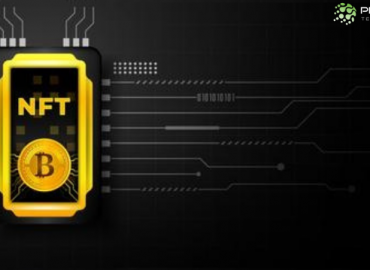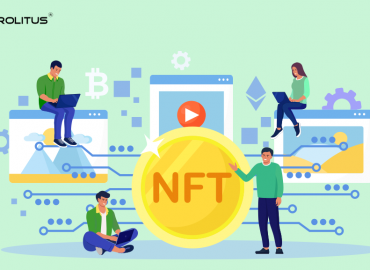People’s faith in non-fungible tokens (also known as NFTs) has increased alongside the network’s growing number of users ever since their introduction. One of the many issues that have arisen concerning NFT over the course of time is the question of how to choose the most suitable blockchain platform on which the NFT may be constructed. When it comes to getting NFT development services, security is one of the most important things for businesses to think about. These companies will do anything to keep their customers’ data safe.
For some time now, Ethereum, one of the blockchain networks, has been widely regarded as the most suitable option for commercial use. But things have changed, and businesspeople are expressing interest in developing the NFT economy on Polygon now that the timing is right. You are probably wondering what the heck Polygon (Matic) is at this point, as well as why companies would want to use an NFT marketplace based on Polygon. If you have no prior knowledge of this topic, then you have arrived at the right place.
In the following, we will give you a comprehensive explanation of the Polygon Blockchain and explain how obtaining access to the Polygon NFT marketplace can be useful to you. Without further ado, let’s get into the specifics of the situation:
What is Polygon Matic?
Polygon is a protocol stack that was designed with the purpose of fixing Ethereum’s scalability issues. This was the motivation behind its creation. The problems that afflict the Ethereum network are solved by the Polygon network, which manages transactions on a distinct blockchain that is interoperable with Ethereum. This network eliminates the problems that plague the Ethereum network.
Following the completion of the processing of the transactions, Polygon sends them to be transmitted to the primary Ethereum network. This tactic eases the burden that is imposed on Ethereum’s distributed ledger system (the network). As a result of this, Polygon is able to speed up transactions while also lowering the cost of doing so to less than a cent.
To put it another way, Polygon, which was once known as the Matic network, makes it easy for existing as well as brand-new blockchain applications to be created on Ethereum without running into problems with scaling.
When users connect to any decentralized application (DApp), they may do so using Polygon without ever having to worry about the network getting overloaded. This is because Polygon was designed to prevent users from creating duplicate connections.
This all-encompassing tutorial covers everything there is to know about the Polygon Matic network, including how Polygon functions and how this innovative solution is making Ethereum more user-friendly.
How Does the Polygon Work?
You may consider Polygon to be comparable to an express train that operates on a metro system. It travels the same route as the regular train, but it halts at a substantially lower number of stations than the regular train does, which enables it to go at a significantly faster rate. (The main Ethereum blockchain may be compared to a local train in this hypothetical situation.) Polygon uses a number of different technologies to set up this lightning-fast parallel blockchain and connect it to the regular Ethereum blockchain.
Polygon utilizes a proof-of-stake consensus method as a means of creating new MATIC and maintaining the integrity of the network in order to accomplish both of these goals. This suggests that taking part in stakes is one of the ways you might earn money using MATIC that you already own. Other possible possibilities include:
It is the role of the validators to ensure that any new transactions are legitimate before adding them to the distributed ledger, often known as a blockchain. As a kind of compensation, they may be eligible for a share of the newly established MATIC as well as the fees. Becoming a validator is a time-consuming and involved process that requires constantly running a node (or computer) and staking your own MATIC. If you want to become a validator, you will need to run a node (or computer) around the clock. If you make a mistake, act in a way that is intentionally against the rules, or even if your internet connection encounters technical issues, you face the danger of losing some of the MATIC that you have staked.
In a roundabout way, the MATIC assets of delegates are staked by going through a reliable validator. A lot less of a personal commitment is needed from you when you participate in this kind of staking. However, prior research is still required because, depending on the actions of the validator that you select, you can wind up losing some or all of the MATIC that you have staked. This is because the behavior of the validator is unpredictable.
NFT Marketplace on Polygon
Every new cryptocurrency makes it a priority to join the Ethereum blockchain network as quickly as possible. This is due to the fact that the Ethereum blockchain network is the one that has the most users in the cryptocurrency market. The network’s trustworthiness and heritage are built on top of its reliability and network stability, which are the foundations upon which they are built. Despite this, a significant degree of concern has been expressed regarding Ethereum’s capacity to scale. Polygon NFT, Ethereum’s layer two protocol, was designed as a response to the issue so that it could be solved. The blockchain and Polygon NFT share some similarities, but they are not the same thing. Referring to it by the phrase “side chain” is how those who work in the industry typically do so.
Polygon Matic NFT Marketplace was established in 2017 as a submarket of Matic NFT Marketplace, which is also an umbrella market. Architects Sandeep Nailwal, Jainti Kanani, Anurag Arjun, and Mikhailo Beli were responsible for the creation of the network. In February of 2021, the creators of Matic Network came to the conclusion that it would be best to rename and rebrand their product as Polygon. They provided an updated strategy for the expansion of the project, in which they said that the L2 solution would eventually develop into a multi-chain system. This was presented as part of the presentation.
Polygon was once known by its previous name, which was Matic; the objective of the Matic NFT project is to link and develop blockchain networks that are compatible with Ethereum. The ultimate goal of Matic is to create an environment similar to Ethereum, where users can use all of the features and functions that the Ethereum platform is able to offer.
Since July 2021, Matic NFTs have been available for trading on OpenSea through the Polygon network. OpenSea on Polygon has the potential to cut costs for Ethereum gas and speed up transaction times.
Over 102,000 deals were completed each day throughout the month of January, bringing the total volume of trades conducted on OpenSea through Polygon to $78.9 million. Polygon analyst Gogia says that people who used Polygon instead of Ethereum’s main chain saved an average of $195.6 every month.
In January, more than $79 million was traded in Polygon Matic NFT. This is a 4% increase from December and a 465% increase from July 2021.
Despite the fact that the Polygon network does not have sufficient liquidity, Ethereum Layer-1 has more buyers. Dune Analytics says that there were NFT trades worth $5 billion on the Ethereum base chain in the month of January.
In comparison to Ethereum’s 2.4 million, Polygon sold 2.6 million NFTs throughout the month of January. It demonstrates that customers will trade more if there is a reduction in the cost of gas.
What are the benefits of building an NFT marketplace on Polygon?
Polygon, a blockchain platform provider, is releasing a new product dubbed the Polygon Marketplace. The marketplace will allow users to buy and sell digital assets, including NFTs (non-fungible tokens), on the platform. The Polygon Marketplace is designed to provide users with a faster and more efficient experience when buying and selling digital assets. The marketplace also allows users to manage their digital assets in one place, making it easier to track their investments.
The benefits of using the Polygon Marketplace include improved security and speed. Through the Polygon Marketplace, buyers and sellers can easily verify each other’s identities and transactions through blockchain technology. Additionally, the marketplace eliminates the need for third-party exchanges, which can be risky and difficult to use. Lastly, you can keep track of your investments better if you put all of your digital asset transactions on one platform.
Features of the NFT marketplace built on Polygon
The Polygon NFT marketplace offers various features.
Scalability: Polygon networks carry out multiple transactions in a quick and trouble-free manner. This feature enables the Polygon NFT marketplace to be highly scalable.
Compatibility with Ethereum: This feature enables Ethereum-compatible blockchains to communicate with one another and reduces the limits placed on fully utilizing Ethereum’s ecosystem.
Sovereignty: Connects to the Ethereum network to give sovereign blockchains the ability to use multiple chains, which lets thousands of transactions happen every second.
Security: Security is provided by a group of validators who employ algorithms to make possible secured financial transactions.
Modularity: Benefit from a platform that is modular and can be extended, customized, and upgraded. By permitting multiple levels of setup, you can prevent system breakdowns from occurring.
Interoperability: This is made possible by Polygon, which lets Polygon chains connect to other blockchain networks.
How to Develop an NFT Marketplace on Polygon
The rise in popularity of non-fungible tokens (NFTs) has resulted in an increase in demand for platforms that facilitate the establishment of NFT marketplaces that are built on Ethereum and Polygon. Due to the fact that there is a significant demand for it, Polygon has also been playing an active role in the Matic NFT marketplace. This marketplace gives companies a chance to stand out from the competition by giving them better dependability, security, and scalability.
The ease with which it is possible for companies to build their NFT marketplaces is the primary motivation for the growing popularity of NFT marketplace creation based on Matic among enterprises, comparable to other types of NFT markets that give consumers the ability to buy, sell, and browse digital collectibles. Additionally, users are able to acquire assets or participate in auctions on the Polygon site. The Matic NFT marketplace makes it easier for chains to work together and adds extra safety measures for chains that work together.
You will need to use a Node.js app in conjunction with a framework in order to create an NFT marketplace on the Polygon platform. NFT businesses, newcomers, and other fans will find it easier to get a platform with lots of features if they get help from a reputable organization that specializes in building NFT marketplaces.





